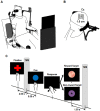Motor cortex-evoked activity in reciprocal muscles is modulated by reward probability
- PMID: 24603644
- PMCID: PMC3948372
- DOI: 10.1371/journal.pone.0090773
Motor cortex-evoked activity in reciprocal muscles is modulated by reward probability
Abstract
Horizontal intracortical projections for agonist and antagonist muscles exist in the primary motor cortex (M1), and reward may induce a reinforcement of transmission efficiency of intracortical circuits. We investigated reward-induced change in M1 excitability for agonist and antagonist muscles. Participants were 8 healthy volunteers. Probabilistic reward tasks comprised 3 conditions of 30 trials each: 30 trials contained 10% reward, 30 trials contained 50% reward, and 30 trials contained 90% reward. Each trial began with a cue (red fixation cross), followed by blue circle for 1 s. The subjects were instructed to perform wrist flexion and press a button with the dorsal aspect of middle finger phalanx as quickly as possible in response to disappearance of the blue circle without looking at their hand or the button. Two seconds after the button press, reward/non-reward stimulus was randomly presented for 2-s duration. The reward stimulus was a picture of Japanese 10-yen coin, and each subject received monetary reward at the end of experiment. Subjects were not informed of the reward probabilities. We delivered transcranial magnetic stimulation of the left M1 at the midpoint between center of gravities of agonist flexor carpi radialis (FCR) and antagonist extensor carpi radialis (ECR) muscles at 2 s after the red fixation cross and 1 s after the reward/non-reward stimuli. Relative motor evoked potential (MEP) amplitudes at 2 s after the red fixation cross were significantly higher for 10% reward probability than for 90% reward probability, whereas relative MEP amplitudes at 1 s after reward/non-reward stimuli were significantly higher for 90% reward probability than for 10% and 50% reward probabilities. These results implied that reward could affect the horizontal intracortical projections in M1 for agonist and antagonist muscles, and M1 excitability including the reward-related circuit before and after reward stimulus could be differently altered by reward probability.
Conflict of interest statement
Figures





References
-
- Wickens JR, Reynolds JN, Hyland BI (2003) Neural mechanisms of reward-related motor learning. Curr Opin Neurobiol 13: 685–690. - PubMed
-
- Calabresi P, Picconi B, Tozzi A, Di Filippo M (2007) Dopamine-mediated regulation of corticostriatal synaptic plasticity. Trends Neurosci 30: 211–219. - PubMed
-
- Lang N, Speck S, Harms J, Rothkegel H, Paulus W, et al. (2008) Dopaminergic potentiation of rTMS-induced motor cortex inhibition. Biol Psychiatry 63: 231–233. - PubMed
Publication types
MeSH terms
LinkOut - more resources
Full Text Sources
Other Literature Sources

